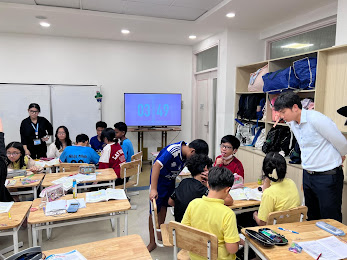D. Teaching Practice
I. Procedures of Teaching
In my teaching procedures, I begin by establishing clear class management rules to create a respectful and productive learning environment. Taking attendance is the next step, allowing me to monitor student participation and engage with those who may need additional support. After attendance, I present the lesson objectives clearly, explaining what students will learn and how it connects to their prior knowledge. To spark interest, I incorporate a motivational activity—such as a thought-provoking question or a brief video clip—that encourages students to think critically about the topic at hand.
Following this, I present the lesson content using various teaching aids, including slideshows and multimedia resources, ensuring the material is engaging and accessible. This is complemented by an initial activity that reinforces the lesson, whether through group exercises or hands-on experiments. I then facilitate a class discussion to deepen understanding, prompting students with open-ended questions that connect the lesson to broader themes and current events. To further engage them, I introduce an additional activity, such as group projects or role-playing, that allows for creative application of their knowledge.
Next, I provide opportunities for students to apply what they've learned in real-world contexts, discussing current events relevant to the lesson. At the end of the session, I conduct a brief evaluation to assess understanding through exit tickets or informal questioning, using this feedback to inform my future teaching. Finally, I outline the assessment methods that will gauge their overall performance, including both formative assessments like quizzes and summative assessments such as tests and presentations. Through these structured procedures, I aim to foster a dynamic and engaging learning environment that promotes active participation and meaningful application of knowledge.
II. Time Management and Organizing Activities
In managing my 40-minute class time effectively, I prioritize time management and organization to ensure that each lesson is both comprehensive and engaging. I begin by carefully planning the structure of the class, breaking it down into segments that allow for a balance of instruction, activities, and discussion.
When designing activities, I typically allocate 5 to 10 minutes, depending on the complexity of the task. This time frame encourages students to stay focused and engaged while still allowing them to explore the material actively. I communicate clear instructions and expectations at the beginning of each activity to maximize productivity.
Additionally, I set time limits for each segment of the lesson, using timers or visual cues to keep everyone aware of the remaining time. This not only helps students manage their time during activities but also keeps the class on track. I make sure to leave a few minutes at the end of the lesson for wrap-up and reflection, allowing students to share their insights and clarifying any lingering questions.
By organizing activities within a structured time framework, I create a dynamic learning environment where students can actively participate while also respecting the constraints of the class period.
III. Classroom Management
In my approach to classroom management, I utilize an engaging acronym that aligns with our discussions to keep students focused and motivated. This strategy serves as a reminder of the key principles we discuss and helps maintain a positive learning atmosphere.
When the classroom becomes noisy, I implement my "song strategy"—a simple tune that signals students to refocus their attention on me and quiet down. This musical cue not only captures their interest but also establishes a routine that they can easily follow.
I recognize that following instructions can be challenging, particularly for students who may not fully understand the English language. However, with the invaluable support of my supervisor at Dong Thap University and my Vietnamese buddies, I’ve developed strategies to bridge this language gap. Together, we create a collaborative environment where I can provide clear, simplified instructions and utilize visual aids to enhance comprehension.
With these strategies in place, classroom management runs smoothly, allowing students to engage meaningfully with the content while fostering a respectful and productive learning environment. By actively involving students in the management process and addressing their unique needs, I ensure that everyone feels included and empowered to participate.
IV. Problem-Solving While Teaching and Staying in the Designated School
While teaching and staying at Future School, I encountered various challenges that required effective problem-solving strategies. One significant issue was the language barrier, as many students struggled to understand English instructions. To address this, I implemented a multi-faceted approach. I simplified my language, used visual aids, and encouraged peer support, allowing students to explain concepts to each other in their native language when necessary. This not only helped improve comprehension but also fostered collaboration among students.
Another challenge was maintaining student engagement during lessons. To combat this, I integrated interactive activities and games into my lessons, making learning more dynamic and enjoyable. I also sought feedback from my students about what activities they found most engaging, which allowed me to tailor future lessons to better meet their interests and needs.
Additionally, classroom management occasionally posed difficulties, particularly with maintaining focus during discussions. To solve this, I introduced a structured routine that included clear expectations and engaging signals, such as my song strategy to regain their attention. This helped establish a consistent environment where students felt secure and focused.
Throughout my teaching experience, I learned the importance of adaptability and collaboration. By actively seeking solutions and being open to trying new strategies, I was able to create a supportive learning environment that encouraged student growth and engagement. The support from my supervisor and fellow teachers also played a crucial role in navigating these challenges, as we shared ideas and strategies that benefited our teaching practices.





Comments
Post a Comment